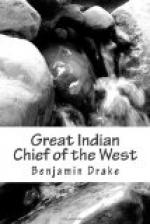These historical facts are interesting, as showing the manner in which the Sauks and Foxes obtained possession of the fertile plains of Illinois; and, as adding another to the many instances on record, in which hordes of northern invaders have overrun and subjugated the people of more southern regions. The causes are obvious for this descent of the Sauks and Foxes, upon their southern neighbors. They reached a more genial climate, a country where game was more abundant than in the region they left behind, and in which they could, with greater facility, raise their corn, beans and pumpkins. Other causes than these might have had their influence. The Illini confederacy may have provoked the descent of the northern tribes upon them. On this point, Lieutenant Pike in his travels to the sources of the Mississippi, has the following remark.
“By killing the celebrated Sauk chief, Pontiac, the Illinois, Cahokias, Kaskaskias and Peorias, kindled a war with the allied nations of the Sauks and Reynards, which has been the cause of the almost entire destruction of the former nations.”
The death of Pontiac may have been the immediate exciting cause of the war, but it is more than probable that the love of conquest and the hope of obtaining a more fruitful and genial country, than is to be found upon the shore of the lakes, were the principal reasons which impelled the northern confederacy to the subjugation of the Illini.
The principal village of the Sacs and Foxes, for a long period of time, was on the north side of Rock river, near its junction with the Mississippi. It contained at one time upwards of sixty lodges, and was among the largest and most populous Indian villages on the continent. The country around it is fertile and picturesque, finely watered, and studded with groves and prairies. It is described in the following graphic manner, by a gentleman[3] who travelled over it in 1829.
“The Mississippi, which below its junction with the Missouri, is a troubled stream, meandering through low grounds, and margined by muddy banks, is here a clear and rapid river, flowing over beds of rock and gravel, and bordered by the most lovely shores. Nothing of the kind can be more attractive, than the scenery at the upper rapids. On the western shore, a series of slopes are seen, commencing at the gravelly margin of the water, and rising one above another, with a barely perceptible acclivity, for a considerable distance, until the back ground is terminated by a chain of beautifully rounded hills, over which trees are thinly scattered, as if planted to embellish the scene. This is the singular charm of prairie scenery. Although it is a wilderness, just as nature made it, the verdant carpet, the gracefully waving outline of the surface, the clumps and groves and scattered trees, give it the appearance of a noble park, boundless in extent, and adorned with exquisite taste. It is a wild but not a savage wild, that




